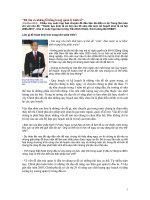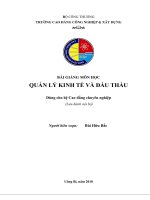chap 2 quản lý kinh tế học
Bạn đang xem bản rút gọn của tài liệu. Xem và tải ngay bản đầy đủ của tài liệu tại đây (17.75 KB, 6 trang )
CHAPTER TWO
OPTIMAL DECISIONS USING
MARGINAL ANALYSIS
ANSWERS TO EVEN-NUMBERED PROBLEMS
2.
The revenue function is R = 170Q - 20Q2. Maximizing revenue
means setting marginal revenue equal to zero. Marginal revenue is:
MR = dR/dQ = 170 - 40Q. Setting 170 - 40Q = 0 implies Q = 4.25
lots. By contrast, profit is maximized by expanding output only to
Q = 3.3 lots. Although the firm can increase its revenue by
expanding output from 3.3 to 4.5 lots, it sacrifices profit by doing so
(since the extra revenue gained falls short of the extra cost incurred.)
4. a. π = PQ - C
= (120 - .5Q)Q - (420 + 60Q + Q2)
= -420 + 60Q - 1.5Q2.
Mπ = dπ /dQ = 60 - 3Q = 0
Solving yields Q* = 20
Revenue = PQ = (120 - .5Q)Q = 120Q - .5Q2; MR = 120 - Q
Cost = -420 + 60Q + Q2; MC = 60 + 2Q
Equating marginal revenue and marginal cost yields:
120 - Q = 60 + 2Q or Q* = 20
b. Here, R = 120Q; it follows that MR = 120
Equating marginal revenue and marginal cost yields
120 = 60 + 2Q or Q* = 30
6. a. If videos are given away (P = $0), demand is predicted to be:
John Wiley & Sons
2-1
Q = 1600 - (200)(0) = 1,600. At this output, firm A’s cost is
1,200 + (2)(1,600) =$4,400, and firm B’s cost is (4)(1,600) = $6,400.
Firm A is the cheaper option and should be chosen. (In fact, firm A
is cheaper as long as Q > 600.)
b. To maximize profit, we simply set MR = MC for each supplier and
compare the maximum profit attainable from each. We know that
MR = 8 - Q/100 and the marginal costs are MC A = 2 and MCB = 4.
Thus, for firm A, we find: 8 - QA/100 = 2, and so QA = 600 and PA =
$5 (from the price equation). For firm B, we find that Q B = 400 and
PB = $6. The station’s profit is: 3,000 - [1,200 + (2)(600)] = $600
with firm A. Its profit is 2,400 - 1,600 = $800 with firm B. Thus, an
order of 400 videos from firm B (priced at $6 each) is optimal.
8. a. First note that if marginal cost and marginal benefit to consumers
both increased by $25, the optimal output would not change since
MR(Q*) = MC(Q*) and MR(Q*) + 25 = MC(Q*) + 25 are
equivalent. The price would rise by $25 but, since marginal costs
rise by $25, the firm’s total profits would remain the same. If
marginal costs rose by more than $25, profits would fall. Thus the
firm should not redesign if the increase in MC is $30.
b. If MC increases by $15 and MR increases by $25, the MR shift is
greater than the MC shift and the new intersection of the curves
occurs at a higher output. Output and price would both rise. Price,
however, would rise by less than $25.
10.
The latter view is correct. The additional post-sale revenues increase
MR, effectively shifting the MR curve up and to the right. The new
intersection of MR and MC occurs at a higher output, which, in turn,
implies a cut in price. (Of course, one must discount the additional
John Wiley & Sons
2-2
profit from service and supplies to take into account the time value
of money.)
12. a. The MC per passenger is $20. Setting MR = MC, we find 120 - .2Q
= 20, so Q = 500 passengers (carried by 5 planes). The fare is $70
and the airline’s weekly profit is $35,000 - 10,000 = $25,000.
b. If it carries the freight, the airline can fly only 4 passenger flights,
or 400 passengers. At this lower volume of traffic, it can raise its
ticket price to P = $80. Its total revenue is (80)(400) + 4,000 =
$36,000. Since this is greater than its previous revenue ($35,000)
and its costs are the same, the airline should sign the freight deal.
*14.
The Burger Queen (BQ) facts are P = 3 - Q/800 and MC = .80.
a. Set MR = 0 to find BQ’s revenue-maximizing Q and P. Thus, we
have 3 - Q/400 = 0, so Q = 1,200 and P = $1.50. Total revenue is
$1,800 and BQ’s share is 20% or $360. The franchise’s revenue is
$1,440, its costs are (.8)(1200) = $960, so its profit is $480.
b. The franchise maximizes profit by setting MR = MC. Note that the
relevant MR is (.8)(3 - Q/400) = 2.4 - Q/500. After setting MR = .8,
we find Q = 800. In turn, P = $2.00 and the parties’ total profit is
(2.00 - .80)(800) = $960, which is considerably larger than $840, the
total profit in part a.
c. Regardless of the exact split, both parties have an interest in
maximizing total profit, and this is done by setting (full) MR equal
to MC. Thus, we have 3 - Q/400 = .80, so that Q = 880. In turn P =
$1.90, and total profit is (1.90 - .80)(880) = $968.
d. The chief disadvantage of profit sharing is that it is difficult, timeconsuming, and expensive for the parent company to monitor the
reported profits of the numerous franchises. Revenue is relatively
easy to check (from the cash register receipts) but costs are another
matter. Individual franchises have an incentive to exaggerate the
costs they report in order to lower the measured profits from which
John Wiley & Sons
2-3
the parent’s split is determined. The difficulty in monitoring cost
and profit is the main strike against profit sharing.
Discussion Question
Suppose the firm considers expanding its direct sales force from 20 to, say
23 sales people. Clearly, the firm should be able to estimate the marginal
cost of the typical additional sales person (wages plus fringe benefits plus
support costs including company vehicle). The additional net profit
generated by an additional sales person is a little more difficult to predict.
An estimate might be based on the average profitability of its current sales
force. A more detailed estimate might judge how many new client contacts a
salesperson makes, historically what fraction of these contacts result in new
business, what is the average profit of these new accounts, and so on. If the
marginal profit of a sales person is estimated to be between $100,000 and
$120,000 while the marginal cost is $85,000, then the firm has a clear-cut
course of action, namely hire the additional 1, 2, or 3 employees.
ANSWERS TO SPREADSHEET PROBLEMS
(You may download any and all spreadsheets from the John Wiley
Samuelson and Marks Website.)
S1. a and b. Setting MR = MC implies: 800 – 4Q = 200 + Q. Therefore,
Q* = 120 and P* = 560.
c. Confirm these values on your spreadsheet by maximizing cell F7 by
changing cell B7. Maximum profit in cell F7 is 16,000.
S2. a. Given π = 20[A/(A+8)] –A, it follows that Mπ = 20[8/(A+8)2] – 1.
Setting Mπ = 0 implies (A+8)2 = 160, or A* = $4.649 million.
John Wiley & Sons
2-4
b. Confirm this value on your spreadsheet by maximizing cell F7 by
changing cell C7. Maximum profit in F7 is $2.702 million.
S3. a. Using trial and error or the spreadsheet optimizer, we confirm that
the optimal location for the mall is Town E, at coordinates (11, 0).
b. Using the spreadsheet optimizer, we now find the optimal mall
location to be (11.14, 7.3).
c. Now the number of visitors varies with the square of the distance to
the mall. Using the spreadsheet optimizer, our goal is to find the
location that maximizes cell E14. For coastal cities, the optimal
location is (11.05, 0). This is the mean of the one-dimensional
distribution. For cities scattered north-west and east-south the
optimal location is (11.05, 6.5).
ANSWERS TO APPENDIX PROBLEMS
1.
When tax rates become very high, individuals will make great efforts
to shield their income from taxes. Furthermore, higher taxes will
discourage the taxed activities altogether. (In the extreme case of a
100% tax, there is no point in undertaking income-generating
activities.) Thus, a higher tax rate mean a smaller tax base. Increasing
the tax rate from zero, the revenue curve first increases, eventually
peaks, and then falls to zero (at a 100% tax). Thus, the curve is shaped
like an upside-down U.
2. a. B(t) = 80 - 100t. Therefore, R = 80t - 100t2. Setting MR = dR/dt = 0,
we find: 80 - 200t = 0, or t = .4.
b. B(t) = 80 - 240t2. Therefore, R = 80t - 240t3. Setting MR = dR/dt = 0,
we find: 80 - 720t2 = 0. Therefore, t2 = 1/9, or t = 1/3.
John Wiley & Sons
2-5
c. B(t) = 80 - 80t.5. Therefore, R = 80t - 80t1.5. Setting MR = dR/dt = 0,
we find: 80 - 120t.5 = 0. Thus, t.5 = 2/3, or t = 4/9.
3. a. π = 20x - x2 + 16y - 2y2. Setting dπ/dx = 0 and dπ/dy = 0 implies
x = 10 and y = 4.
b. The Lagrangian is L = π + z(8 - x - y). Therefore, the optimality
conditions are: 20 - 2x - z = 0, 16 - 4y - z = 0, and x + y = 8. The
solution is x = 6, y = 2, and z = 8.
c. The Lagrangian is L = π + z(7.5 - x - .5y). Therefore, the optimality
conditions are: 20 - 2x - z = 0, 16 - 4y - .5z = 0, and x + .5y = 7.5.
The solution is x = 6, y = 3, and z = 8.
John Wiley & Sons
2-6









